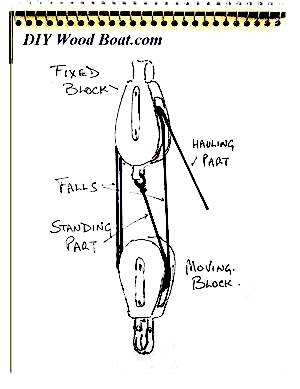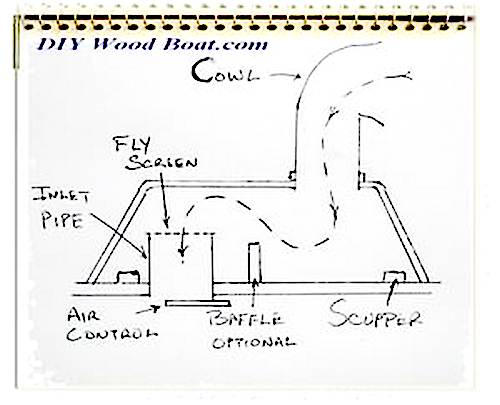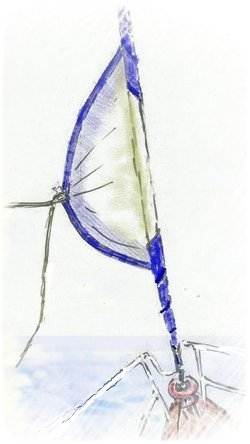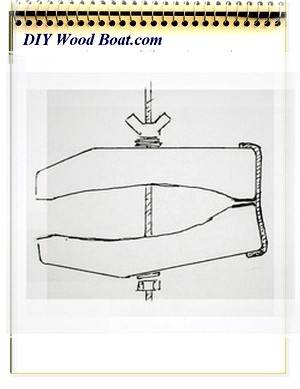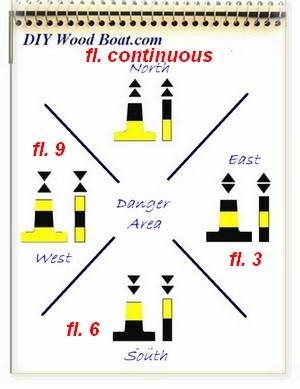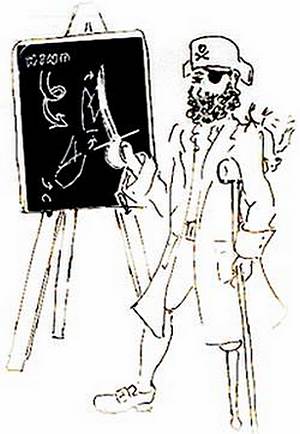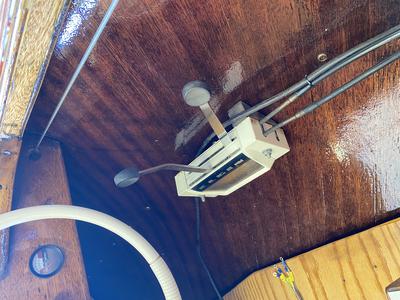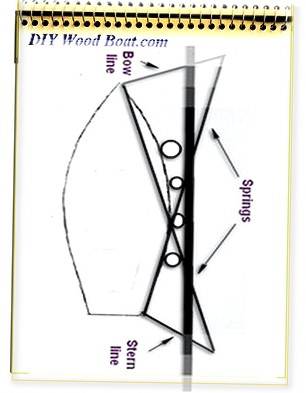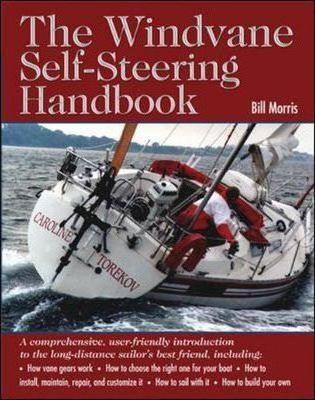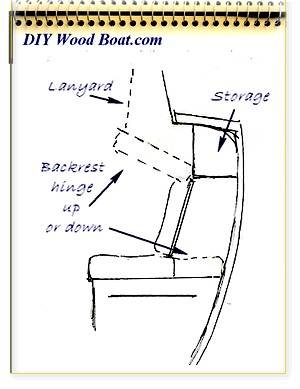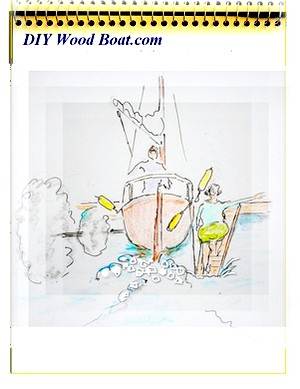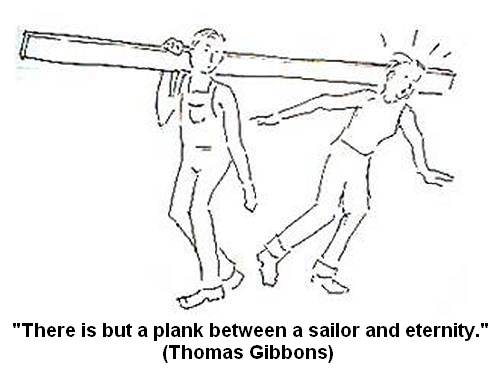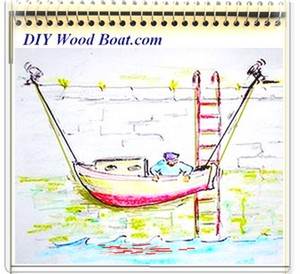- Home
- Your Boats
- Boating Terms
Boating Terms.
The ABC of Boating Terms
Boating, as with any specialist endeavor has its own specific set of terms.
As boats evolved from the basic dugout canoe so a lexicon needed to identify their various parts evolved.
The sciences have used the 'dead' language of Latin to give precise unchanging definitions.
However, the boating fraternity, being practical people, have used their own, often colloquial languages to define and describe their craft.
Many modern boating terms, particularly in 'living', evolving, English with its various idioms have evolved from the archaic.
Boating Terms begining with A
ABACK When the wind presses back on the sails
When the wind presses in a backward direction on the sails.
'Taken aback' nowadays means to be startled enough to make one jump back in surprise.
In the days of square sail ships to be 'aback' was if the wind were to turn suddenly or if there were a problem at the helm, so that the ship was facing unexpectedly into the wind and it was blowing the sails flat back against the masts and spars.
If this happened unexpectedly it certainly would be enough to startle the crew and make them jump back in surprise, it could also severely damage the rigging.
However, 'backing' the sails in a controlled manner could be used as a legitimate maneuver, such as to slow the ships progress or 'backing a headsail to help tack a boat that is slow in stays.
ABAFT Toward the rear of or behind the boat.
ABEAM At right angles to the boats length.
ABOARD On or inside the boat.
ABOUT Change of direction.
ABREAST Side by side, along side.
ADRIFT Not moored, at anchor or under way.
AFT Toward the rear of the boat.
AHEAD In front of or moving forward.

AIR-DRIED (Timber) Wood which has been either seasoned naturally either outdoors or in an unheated shed.
ALEE Away from the direction of the wind.
ALOFT Above the deck of the boat, overhead.
AMIDSHIPS The center of the boat. {everything; surrounded by ships}
AMINE BLUSH The waxy residue which forms on epoxy after it is cured.
ANCHOR A device for holding a boat in position, normally a heavy hooked device for holding her to the sea floor, also sea anchor to restrain her movements at sea.
{everything; a device designed to bring up mud samples from the bottom at inopportune times.}
ANCHORAGE A sheltered place suitable for anchoring. These day usually filled with moorings or marinas.
ANTIFOULING The paint used on the bottom of the boat to prevent barnacles and other organisms from growing on the ship's bottom.
APPARENT (wind) The apparent direction of the wind, as is felt on deck. This is a combination of the true wind and that created by the boats movement.
ASTERN Behind the boat, or moving in reverse.
ASPECT RATIO The relationship between the height of a sail and its breadth.
ATHWARTSHIPS Across at right angles to the centreline of the boat.
More boating terms>
Boating Terms begining with B
BACKSPLICE; A method of splicing rope ends to prevent fraying.
BACKSTAY; A line running from the masthead to the stern to support the mast.
BAGGYWRINKLE ;
Chafing gear, traditionally made from old (twisted strand) ropes and used on shrouds and spreaders to prevent them wearing the sails (see Chafing Gear). {Older members of the crew.}
BALLAST; Weight carried low down in a boat to increase stability.
BARE BOAT; Usually refers to chartering a boat without a crew, one you sail yourself. {alt; nude sailing}
BARNEGAT BAY SNEAKBOX: A small, round-bottom water-fowling boat of Barnegat Bay, New Jersey.
BAROTO; A Hiligaynon (Philippine) term for boat, usually made up of wood from different type of trees found in the locality. It has a katig or a wooden framework attached to each side of the boat for support.
BATTEN A thin strip of hard material, such as wood or plastic. On a sail these are used to stiffen and shape the leech.
BATTEN POCKETS Pockets on the leach of a sail to hold the battens.
BEAM The greatest width of the boat.
BEAM; At right angles to the boat's length.
BEAM ENDS; A boat is said to be on her beam ends when she is healed right over.
BEAM, MAIN; The beam immediately behind the main mast.
BEAMS; The transverse timbers stretching from one side of the boat to the other, usually supporting the decks.
BEARING; A compass direction of either an object from the boat or in relation to the heading of the boat.
BECKET; A loop at the end of a line or on a block.
BELOW Beneath the deck, inside.
BERTH; A bunk or bed space on board. Or a designated mooring. Or as in a wide berth a safe and cautious distance. {alt; the arrival of a brand new crewmember}
BIGHT [see Knots]
BILGE The lowest part of the hull below the level of the cabin sole.
BILGE PUMP; A pump used to remove water from the bilge.
BILGE STRINGERS; Stiffening strakes fitted inside the hull, on both sides, below the turn of the bilge.
BIMINI; A cockpit cover to give shelter the from the sun.
BINNACLE; A pedestal or mounting which holds the compass.
BIRCH-BARK CANOE; A canoe with hull covered by one or more pieces of stitched birch-bark.
BITT; A sturdy post on which to tie anchor or mooring lines.
BITTER END; (see Knots)
boating terms
BLOCKA wood, metal, or synthetic casing containing one or more pulleys or sheaves.
BLOCK AND TACKLE A combination of blocks used to create the mechanical advantage to easily move heavy loads.
BOAT HOOK A hook on a shaft used for picking up lines moorings or fending off.
BOBSTAY A chain, line, or rod holding a bowsprit or boomkin against upward pull.
BOLLARD A pillar or post for attaching mooring lines.
BOLT ROPE A line which is sewn into the edge of a sail to strengthen it.
BOOM VANG Or kicking strap, is a system used to hold down the boom of a sail.
BOOM The pole along the bottom of a sail, which pivots at the mast and controls the angle of the sail. {everything; so called boom for the sound it makes when it hits crew on the head}
BOOMKIN A spar projecting from the stern to which a backstay is attached.
BOOT TOP A decorative line painted along the waterline.
BOSUON'S CHAIR A sling in which to sit while working up the mast can be used to hoist someone aloft.
BOW The front part of a boat (usually, but not always, the pointed end).
BOW LINE A mooring line leading outwards at an angle from the bow.
BOWLINE [see knots]
BOWSPRIT A spar extending forward of the bow to which the fore sail / sails are fastened.
BREASTHOOK A horizontal knee which fits in the stem and to which the sheers are attached.
BRIGHT WORK A term used to describe wood that is finished natural, using varnish or other clear coating.
BROACHING When a vessel is turned broadside on the oncoming waves.
BROAD ON THE BEAM When an object that lies at right angles to one side of the vessel.
BROAD REACH Sailing with the apparent wind coming at right angles to the beam of the boat.
BULKHEAD An interior vertical athwart ships partition, often serving as a set-up member or frame
boating terms
BULWARK An extension of the timbers above the deck to form a rail.
BURGEE A triangular shaped flag denoting the yacht club or association to which the owner belongs.
BUTT A method of joining timbers.
More boating terms >>>>>>
Boating Terms begining with C
CABIN A room or compartment inside a boat.
CAM CLEAT A jamming mechanical used to hold a line automatically using two spring loaded grips.
CANOE STARS; A pointed stern.
CAPSIZE Two over turn.
CAST OFF To let go mooring ropes.
CAR A fitting which slides along a track which allows for the adjustment of the lead of blocks or other fairleads.
CARBON FIBER A strong lightweight material using carbon based fibers in an epoxy base.
CARLIN Structural timbers running fore and aft between the beams supporting the inboard side of the side deck.
CARVEL PLAN KING
See Carvel Planking
CATAMARAN
A boat with twin hulls.
CAULKING The compound used to seal the seams in a wooden boat.
CAVITATION When the tips of a propeller either break the surface of the water or spin too fast causing air bubbles to form.
CELESTIAL NAVIGATION The art of navigating by using the stars, sun and moon to determine one's position.
CENTER OF EFFORT (Sail) The geometric center of the sail at which the pressure of the wind is concentrate.
CENTER OF LATERAL RESISTANCE (CLR) The geometric center or pivot point of the hull profile
CENTRE LINE An imaginary line running from bow to stern along the center of the boat.
CENTERBOARD An adjustable keel which can be raised or lowered.
CHAFING GEAR Tubing or cloth or baggywrikle wrapped around a
line to prevent chafing (see BAGGYWRINKLE)
CHAIN PLATES Plates on the side of the hull to which shrouds and stays are attached.
CHANDLERY A shop that sells boating gear
CHART A map of coastlines for use by navigators. {alt; tells you exactly where you have run aground}
CHART TABLE The table where the navigator charts and plot his course.
CHECKING (in wood) Where wood fibres separate on the surface usually as a result of stresses during drying or bending.
CHEEK BLOCK A block with one side permanently attached to a surface.
CHINE The angle between the bottom and sides of a flat or v-bottomed boat.
CHROMONETER An accurate clock or watch which is used for navigation.
CLEAT A horn shaped fitting to which lines can quickly be made fast.
CLEVIS PIN A metal pin used to attach fittings to each other or their mounts.
CLEW; (see also Clue) The lower aft corner of a triangular sail where the controlling sheets are attached, traditionally this spelling referred to the corners of a hammock.
CLINKER: A method of planking where the plank edges overlap.
CLOVE HITCH See Knots
CLUE: (see also Clew) The traditional spelling for the lower corners of a square sail. Another of those boating terms that have entered the mainstream vocabulary. {alt; something the skipper often lacks}
COAMING A vertical edge around a cockpit or hatch to prevent water on deck from entering.
COCKPIT An protected area of the deck from where the boat is controlled.
COIL To tidy a line or rope in circular loops.
COLREGS The international rules for prevent of collisions at sea.
COMPANIONWAY The entryway into the cabin from the deck or any passageway on board.
COMPOSITE; Construction An object made with more than one type of material.
COURSE; The compass direction in which a boat is to be steered {alt.the language the skipper uses when the helmsman doesn't follow it}
COWLS; Scoops used to direct air into a boat.
CQR; anchor A plough shaped anchor designed to bury itself easily into the sea bed.
CRAB GARVEY; A small, flat-bottomed boat commonly found along the New Jersey (USA) coast with broad, square ends used for catching and transporting crabs.
CRADLE; A frame used to support a boat when on the hard.
CRINGLE; A metal ring or grommet used to reinforce the edge of a hole in material such as sailcloth.
CROSS-PLANKING; Installing bottom planks at right angles to the boat's centreline.
CUDDY; A small sheltered area often in the fore peak of a boat.
CURRENT; The directional movement of water.
boating terms
Boating Terms begining with D
DACRON A synthetic polyester sail cloth.
DAGGERBOARD A narrow blade shaped centerboard which is raised vertically.
DANFORTH Anchor A lightweight anchor with flat, pivoting flukes.
DAVITS Supports projecting over the side of a boats used for raising and lowering a tender.
DAYSAILER A small open boat which would normally not be used for overnighting.
DEAD RECKONING A method of charting ones position by based on last known position, speed currents and heading. (Not ‘deduced’ or ‘ded’ but ‘dead’ as in dead ahead.)
DEADLIGHT A fixed port set in the deck to admit light into the cabin.
DECKHEAD The underside of the deck, the cabin ceiling.
DEPTH SOUNDER An instrument used to measure the depth of water.
DEVIATION; Compass errors due to magnetic anomalies within the boat. {alt; any departure from Captain's orders}
DINGHY; A small open boat. {alt; the sound of the ship's bell.}
DISPLACEMENT; The weight of water displaced by a vessel's hull. {alt; when you've docked your boat then can't find her later}
DISPLACEMENT HULL A type of hull which floats in, the water, as opposed to one which floats on top, such as a planning hull.
More boating terms
DISTRESS SIGNALS Any signaling device such as a Flare, flag or electronic beacons which is used to indicate that a vessel is in trouble.
DOCK A protected area to which vessels can be moored such as a pier or wharf.
DODGER In the USA this is the pram like hood which covers the main hatch and helps to shelter the cockpit.In the UK this is the term given to the canvas which is used to shelter the sides of the cockpit.
DOLPHIN Apart from the playful sea mammal this is also the name for a group of piles bound together for use as moorings or as channel markers.
DORADE VENT A type of vent which has internal baffles that allow air into a cabin while keeping water out.
DORY A small, flat-bottomed boat with flaring sidesDRAFT The depth of a boat from the waterline to the bottom of the keel.
DOUBLE-ENDER; A boat which is 'pointed' at both bow and stern, see also 'CANOE STERN'.
DRY ROT A fungal decay in timber.
boating terms
Boating Terms begining with E
EBB A receding or falling tide. ECHO SOUNDER A fish finder or depth sounder which uses timed sound echoes to determine the depth of objects in water.
EDDY Circular swirling water or air currents.
ENSIGN The nautical version of the boat owners national flag.
EPIRB Emergency Position Indicating Radio Beacon. An emergency device that automatically transmits a radio signal indicating the distressed vessel's position.
EQUATOR An imaginary line of latitude around the center of the earth.
ESTIMATED POSITION The assumed position of a boat based on dead reckoning.
EYE SPLICE A loop on the end of a line made by splicing.
boating terms
Boating Terms begining with F
FAIRLEAD; A fitting designed to control the direction of a line with minimal friction.
FAIRING; The process of smoothing, removing dips or bumps.
FASTENING ; An item such as a nail, screw, rivet or bolt used to fasten planks, frames or other parts together.
FATHOM; A nautical unit of measurement equal to 6 feet (182 cm).
FENDER; Protective cushions hung along the side of a boats to prevent damage.
FIBERGLASS; A construction method where layers of woven glass mats are bonded together with an epoxy resin.
FID; A pointed tool used to separate strands of rope when splicing. The term was originally used to denote a wooden implement, the metal variety being referred to as marlinspikes or marling spikes.
FID Swedish; a metal splicing tool with a 'U' shaped cross section, designed to make it easier to 'tuck' the strands.FIDDLE BLOCK; A block with two sheaves one above the other as opposed to side by side and where the top sheave is larger than the bottom one.
FIDDLE; A rail on the edge of horizontal surfaces to prevent objects from sliding off when the boat heels.
FILLET/FILLETING; See Stitch and Glue Joints
FIGURE OF EIGHT; See Knots
FIN KEEL; A narrow, deep, fixed keel.
FISHERMANS; anchor A traditionally shaped anchor.
FIX; A charted position which has been determined by accurately taking bearings from fixed known positions.
FLAKE; To fold or coil neatly.
FLARE; The outward curve of a vessel's sides towards the bow. A pyrotechnic distress signal.
FLEMISH; To coil a line flat on the deck in spirals.
FLITCH; A log sawn on two or more sides from which veneer can then be sliced.
FLOOD tide; The incoming or rising tide.
FLOTSAM; Debris floating on the water surface which has been washed accidentally from a boat.
FLUKE; The broad flat blade of an anchor designed to dig into the seabed. {alt; any occasion when it digs in on the first try}
FLUSH deck A deck which straddles the width of the boat without any obstructions such as a cabin.
FLYING BRIDGE A high steering position.
FOLLOWING sea Where the waves approaching the boat from astern.
FORE AND AFT Running along the length of the boat.
FORE Boating term for toward the bow, the forward end of the boat.
FORESAIL A sail set forward of the mast.
FORESTAY A supporting line running from the bow of the boat to the upper part of the mast.
FORE TRIANGEL The triangle circumscribed by the mast, the deck, and the forestay.
FORWARD Toward the bow .
FORWARD PERPENDICULAR (F.P.) On a boat plan this is the end station at the stem.
FOUL When a line tangled or becomes jammed. Foul ground indicates an area of seabed with obstructions. {alt; caused by turkeys}
FRACTIONAL rig A type of rig where the jib sail is attached to the mast below the top.
FRAMES Sometimes known as the ribs. The hull framework to which the planks are attached.
boating terms
FREEBOARD The distance from the deck to the waterline. {alt; food and liquor included}
FULLY BATTENED A sail with full length horizontal battens running across the sail.
FURL To roll up a sail around its luff or spar.
FUTTOCK. Any of the curved timbers which are joined together to form the ribs of a wooden vessel; Those next to the keel are known as ground futtocks, those further up as upper futtocks.
FUTTOCK PLATE. An iron plate to which the dead-eyes of the topmast shrouds are secured.
FUTTOCK SHROUDS. Rope, chain, or iron rods which secure the lower dead-eyes and futtock plates of a top mast to rigging to the lower mast.
boating terms
Boating Terms begining with G
GAFF SAIL
See Sail Rigs
GAFF The spar to which the top of a gaff sail is attached. Also a hook
used fro landing fish.
GALE FORCE winds Wind speeds of force 8 (39-46mph) and above.
GALLEY The cooking area of a boat.
GALLOWS A frame used to support the boom when the sail is stowed.
GANGWAY The passageway where people can board and disembark from a boat.
GARBOARD The lowest planks or strakes which adjoining the keel.
GASKET A loop of line as used to tie up furled sails.
GENNEKER A large fore sail that is smaller than a spinnaker but larger than a genoa.
GENOA A large fore sail which reaches back passed the mast.
GIMBALS A hinged arrangement which is designed to hold objects upright as the boat pitched and rolls.
GIVE WAY vessel The vessel which according to the COLREGS should give way to another vessel.
GLOBAL POSITIONING SYSTEM (GPS) A method for ascertaining position using signals received from satellites.
GMT Time measured in Greenwich Mean Time, now known as Universal Time UT. The standard time used in navigation calculations.
GO ABOUT To tack through the wind or change direction.
GOOSENECK The hinged fitting which attaches the boom to the mast, allowing the boom to pivot laterally..
GRAB RAIL Any hand rail.
GREAT CIRCLE Any circle drawn around the earth such that its center is at the center of the earth.A Great circle route will lie along a great circle and is the shortest distance between any two points on the earth's surface.
GROMMET A ring or eyelet.
GROUND TACKLE Any gear used for anchoring.
GUDGON A fitting with a hole into which the pintles or a rudder fit to allow the rudder to turn.
GUNKHOLING Cruising and exploring shallow waters such as creeks.
GUNNEL or GUNWALE The upper edge of a boat's sides
GUY A line used to control, brace or steady something.
GYPSY A windlass or capstan normally used for raising the anchor chain.
GYRE A large circular ocean current.
boating terms
If you haven't already swallowed it, don't put it in the heads
Boating Terms begining with H
HAIL To call another boat or shore, either by voice or on the radio.
HALYARD The line used to hoist the sail or a spar up the mast.
HAND BEARING compass A small portable compass.
HAND LEAD A graduated line with a weight attached, used to determine depth of the water.
HANDY BILLY A portable set of blocks and tackle.
HANGING LOCKER The locker normally used for hanging clothes.
HARD-CHINED A hull shape made with flat panels which join at abrupt angles.
HARDWOOD A description applied to woods from deciduous broad-leafed trees.
HATCH An opening in the deck allowing access to the space below.
HAUL OUT Lifting of a boat from the water.
HAUL Pull.
HAWSE PIPE A hole in the deck for anchor chain or hawsers to run through.
HAWSER A very large diameter rope, usually used for mooring large vessels.
HEAD A marine toilet or the upper corner of a triangular sail. {alt; HEADS UP; leaving the seat up}
HEAD SEA Waves coming at the vessel from the front.
HEAD TO WIND When the boat's bow is facing into the wind.
HEADING The compass bearing in which a vessel is pointing.
HEAD SAIL Any sail hoisted forward of the mast.
HAEDSTAY The foremost line from the bow to the top of the mast.
HEADWAY The forward motion of the boat.
HEARTWOOD The wood at the center of a tree trunk.
HEAVE To throw a line, or to pull strongly. {alt; what you do when you've eaten too much}
HEAVING LINE A light line or messenger used to thrown ashore which can then be used to pull a larger rope.
HEAVE TO Arranging the sails so that they slow or stop the forward motion of the boat and hold her steady.
HEEL When a boat leans away from the wind..
HELM The wheel or tiller a boat.
HELMSMAN The person steering the boat.
HIGH TIDE The point when the tide has reached its highest level.
HITCH A knot used to attach a line to a cleat or other object.
HOIST To raise or pull anything up.
HOLD A compartment below deck used for carrying cargo.
HOLDING tank A storage tank where sewage can be temporarily stored until it can be removed to a treatment facility.
HOOD END The end of a plank where it butts up against the rabbet at the stem of the boat.
HORSESHOE buoy A 'U' shaped floatation device usually with a line attached which can be thrown to people in the water in emergencies.
HOUND A mast fitting used to secure the other fittings to the mast.
boating terms
HULL SPEED The theoretical, maximum speed that a displacement boat can travel without planing.
HULL The main structural body of the boat.
boating terms
Boating Terms begining with I
INBOARD Toward the center or inside or of a vessel,
INFLATABLE A dinghy or raft that can be filled with air for use then deflated for stowage.
boating terms
INTERNATIONAL CODE OF SIGNALS A set of radio, sound, and
visual signals designed to aid in communications between vessels
without language problems. See Signal Flags
IRONS A sailboat is said to be in irons when it is pointing directly into the wind and unable get the sails to fill properly.
ISOBARS Lines drawn on a weather map connecting areas of equal pressure.
boating terms
Boating Terms begining with J
JACK STAY; A strong, well anchored line running the length of a boat to which a safety harness can be attached.
JAM CLEAT; A jamming device to hold a line to stop it slipping.
JETSAM; Any part of a ship, its equipment, or cargo that has been purposefully cast overboard or jettisoned and is then washed ashore.
JETTY; A structure built out from the shore into deeper water so that boats can moor to it.
JIB; A triangular foresail.
JOHNBOAT; A narrow, flat-bottomed, square-ended boat used primarily on inland waterways.
JURY RIG; A temporary, improvised repair.
More boating terms
Boating Terms begining with K
KAYAK;
A decked, canoe-like boat of Eskimo origin.
KEDGE Pulling a boat out of shallow water when it has run aground.
KEEL; The main structural element of a boat running fore and aft on the center line. Also the flat surface projecting from the bottom of the boat to reduce the leeway.
KEELSON; A beam attached to the keel on a wooden boat to add strength.
KERF; The cut made by a saw blade.
KETCH; A sailing boat which has two masts, the forward, taller mast being the main mast. The shorter rear mast is the mizzen.
KILN DRIED; A method of removing moisture from freshly cut green timber in an artificially controlled environment.
KING PLANK; The central plank on a wooden deck.
KNEE; Supporting braces used for strength when two parts are joined at an angle.
KNOT; A speed of one nautical mile per hour. Or a method of tying a rope.
More boating terms >>>
Boating Terms begining with L
LABOURING When a boat is struggling to make way through heavy seas.
LACING A method of attaching something, such as a sail to a spar, with a continuous line.
LAID UP A boat which has been temporally put out of commission.
LAND BREEZE A movement of air from the land to the water due to temperature differences. LANYARD A retaining line, as for instance attached to a tool.
LAPSTRAKE; A method of planking where the plank edges overlap.
LASH To tie.
LATERAL RESISTANCE The ability of a boat to resist leeway or sideways movement.
LATEEN RIG See Sailing Rigs
LATITUDE Imaginary lines drawn around the earth denoting distance, in degrees north and south of the equator.
LAUNCH Putting a boat in the water. Or small motor boat used as a tender.
LAY UP To prepare a boat for temporary decommissioning.
LAY The direction in which a stranded rope has been twisted.
LAZARETTE A small storage space for spare parts and other items in a boat's stern.
LAZY GUY Or preventer a line running from the end of the boom to prevent an accidentally jibe.
LAZY JACK Lines running from above the mast to the boom to retain the sail when it is lowered.
LAZY SHEET The windward jib sheet, the one not currently in use.
LEAD LINE A graduated line with a weight on the end used to measure depth.
LEADING LIGHT Lights spaced by distance and height in such a way that when lined up provide a safe navigational bearing.
LEADING MARK Unlit navigational aids set up like leading lights to indicate a safe bearing.
LEE HELM The tendency of a sailboat to steer away from the direction of the wind.
LEE SHORE The shore towards which the wind is blowing.
LEEBOARD Boards hung from the side of a boat to reduce leeway. Or a board placed vertically along the side of a bunk to keep the occupant from falling out.
LEECH LINE A line used to adjust the aft edge of a sail.
LEECH The after edge of a sail.
LEECLOTH Cloths raised along the side of a bunk to keep the occupant from falling out.
LEEWARD Away from the direction of the wind.
LEEWAY The sideways movement of a boat.
LIFE JACKET A personal floatation device.
LIFE RAFT An emergency raft for use when abandoning ship.
LIFELINE A safety line running fore and aft along the deck of a boat to which the crew can secure themselves.
LIGHTHOUSE A land based structure supporting a navigational warning light.
LIGHTSHIP A ship carrying a navigational warning light which is anchored in a fixed position.
LIMBER HOLE A hole which allows water to drain from a compartment.
LINE A rope.
LIST Leaning to one side
LOA The total length of a boat including any projecting such as bowsprits and bumpkins.
LOCKER An enclosed storage place on a boat.
LOFTING See Lofting
LOG A device used to measure the speed and the distance travelled through the water. Also the written record of a boat's travels.
LOGBOOK The book in which the record of a boat's travels is kept.
LONGITUDINALS Any hull framing members that run the length of the boat.
LONG SPLICE A method of joining two lines of identical thickness by splicing them together.
LONGDITUDE Imaginary lines, drawn on the earth, through the poles, used to measure distance in degrees east and west of the Greenwich meridian.
LOOKOUT A person who is designated to keep watch.
LOOSE FOOTED A sail which is not attached to a boom at its foot.
LOW TIDE The point of a tide when the water level is at its lowest.
LPG Liquid petroleum gas either butane or propane, the fuel common used for cooking on board.
LUBBER LINE A mark on a compass to assist in the reading of the heading.
LUFF ROPE A rope such as a bolt rope in the leading edge of a sail.
LUFF The leading edge of a sail, also used to describe the situation where the leading edge of the sail stalls.
LUFFING The flapping which occurs when the leading edge of sail stalls.
LWL The length of the boat along the waterline.
LYING A HULL When a boat is allowed to drift.
boating terms
Boating Terms begining with M
MAGNETIC BEARING The compass bearing or course or of an object after it has been adjusted for magnetic variation .
MAGNETIC DEVIATION The compass errors due magnetic anomalies within the structure of the boat.
MAGNETIC NORTH The position to which a compass points as opposed to true north.
MAGNETIC VARIATION The angular difference between magnetic north and true north.
MAIN MAST The tallest mast on a boat.
MAIN SAIL The sail which is hoisted from the main mast.
MAIN SHEET The line used to control the angle of the mainsail to the centreline.
MAKE FAST To tie up.
MAKE WAY Move through the water.
MARINA An expensive place to moor a boat. {alt; an up-to-date facility for disposing of your cash, where certain forms of piracy are still permitted}
MARK A navigation buoy or other object used to show a position.
MARLINE Thin line used for whipping, seizing, or lashing.
MARLINESPIKE A pointed tool used to opening the strands of a rope or wire while splicing similar to a fid.
MAST BOOT A protective cover wrapped around the mast at the partners on a keel stepped mast above where it goes through the deck.
MAST PARTNERS Supporting structure which support the mast at deck level and help transfer loads laterally.
MAST STEP The reinforced area where the bottom of the mast is located.
MAST TRACK A track or groove running up the mast to which the luff of the sail is attached.
MAST Any vertical pole or spar protruding above decks on a boat.
MASTHEAD The top of a mast.
MASTHEAD LIGHT The light or lights at the top of the mast.
MASTHEAD RIG Where the forestay is attached to the masthead.
MAYDAY The internationally recognized radio distress signal, must only be used to indicate a life threatening situation.
MEAN LOW WATER The average low tide of a region.
MEDITERRANEAN MOOR A method of mooring with a boat's stern tied to the dock and the bow anchored off.
MERCATOR A method of projecting the spherical globe on to flat charts.
MERIDIAN A line of longitude.
MESSENGER A light line thrown first then used to pull a heavier line or cable.
MIDSHIPS A central area on a boat usually where the beam is widest.
MIZZEN MAST A smaller aft mast on a boat with more than one mast.
MIZZEN SAIL The sail on the mizzen mast.
MOISTURE CONTENT The amount of the water within a piece of timber measured as a percentage of the weight of the dry wood.
MONKEY FIST A large heavy knot in the end of a heaving line to make it easier to throwing.
MONOCOQUE A hull which is made as one continuous piece.
boating terms
MONOHULL A boat that has only one hull.
MOOR To attach a boat to a fixed object.
MOORING A place where there are fixed object to which a boat can be moored.
MOORING BUOY A buoy which is anchored to the seabed to which boats can moor.
MOORING LINE A line used to secure a boat to a mooring.
MOTOR SAILER A boat motor boat which has auxiliary sails.
MOUSING Wrapping with twine.
MULTIHULL A boat with more than one hull.
MUSHROOM ANCHOR An anchor with a heavy inverted mushroom shaped head used to anchor in mud.
boating terms
Boating Terms begining with N
NAUTICAL Pertaining to boats, ships, or sailing.
NAUTICAL ALMANACK A publication containing information on navigational matters.
NAUTICAL MILE A measure of distance equal to one minute of latitude which is approximately 6076 feet.
NAVIGABLE Water which is of sufficient depth to allow a boat navigate.
NAVIGATION The art and science of determining the position of a boat and conducting it safely from one point to another.
NAVIGATIONAL AID Anything which aids the navigator to find his position.
NAVIGATION LIGHTS Lights displayed on a boat which show how it is progressing.
NAVIGATION RULES The regulations governing the movement of vessels in relation to each other.
NAVIGATOR The person responsible for navigating a boat.
NEAP TIDE The tide with the least variation in the range water levels.
NIB END The end of a plank where it becomes narrow.
NOON SIGHT A sextant sighting taken of the sun at noon, when it is at its highest point in the sky.
NOTICE TO MARINERS Official bulletins reporting changes to charts or other navigational items.
boating terms
Boating Terms begining with O
OAR A long bladed apparatus for manually propelling rowing boat.
OARLOCK A pivoting device for holding an oar in place when rowing.
OFFSHORE WIND Wind that is blowing from the land towards the water.
OFFSETS See lofting
OUTBOARD Anything on the outside of a hull.
OUTBOARD ENGINE An engine hung on the outside of a boat.
OUTRIGGER A stabilising float attached to one or both sides of a narrow hull.
OVERFALL Where there are differences in surface level due to the action of currents over the sea bed or in conflict with opposing currents, wind or tide.
OWNERS FLAG A boat owner's private burgee
boating terms
Boating Terms begining with P
PAD EYE A small, guiding, fitting through which a line can be passed.
PAINTER The line made fast to the bow of a dinghy.
PEAK The top aft corner of a gaff sail.
PALM A protective strap with a built in thimble worn on the hand when sewing.
PAN PAN An urgent radio message used to announce a safety concern which is not immediately life threatening.
PARALLEL RULE A pair of rules or straight edges which are mechanically connected so that they can separate yet remain parallel.
PARCEL To wrap a line with protective material.
PARTNERS Supporting structures used to support the mast where it emerges from the deck.
PATENT LOG An apparatus for measuring distance run and boat speed.
PAY OUT To feed out a line.
PEDESTAL The column that a ships wheel is mounted on.
PELOROUS A compass card used to take bearings relative to the ships heading.
PENNANT A small flag.
PIER; A structure extending from the shore out into the water to allow vessels to dock.
PILE; A pole embedded in the seabed.
PILOT; Someone with local knowledge who is qualified to guide a vessels through an area.
PINCH; Steering a sailing boat close to the eye of the wind.
PINTLE; The pin which fits into a gudgeon allowing stern mounted rudder to hinge.
PIROGUE; A canoe-like boat usually of the dugout variety.
PITCH POLE When a boat is tossed end over end.
PITCH; The rocking motion of a boat. Also the curvature of a propeller blade.
PLANNING; When a boat hull skims over the surface of the water.
PLANNING HULL; A hull shape designed to plane.
PLANKING; The wooden strips used to cover a boat's deck and hull.
PLOT; To a fix a ship's course on a chart.
PLOUGH ANCHOR; An anchor such as the CQR shaped like a plow.
PLYWOOD See plywood
POOPED When a wave breaks over the stern of the boat.
PORT The side of the boat on the left when facing forward. An area where ships can unload. Also a window in a boat's side.
PORT TACK When sailing with the wind coming from the port side.
PORTHOLE A circular window in the side of a boat. {alt; when closed it admits light and water, when open it admits, light, air, and insects}
POUND When a boat's bow slams into the oncoming waves.
PRAM A dinghy with a transom and a flat bow.
PREVAILING WIND The typical winds for a particular region and time of year.
PREVENTER A line set up to hold the boom in position and prevent an accidental jibe.
PROPELLER; The bladed part which is spun by the boat's engine to propel the vessel through the water. {alt; underwater winch designed to wind in any lines left hanging over the stern}
PROPELLER SHAFT The shaft joining the engine to the propeller.
PROTRACTOR A navigation tool for measuring angles.
PULPIT The safety rail around the bow.
PURCHASE An arrangement of blocks and tackle which provide mechanical advantage.
PUSHPIT The safety rail around the stern.
boating terms
Boating Terms begining with Q
QUARANTINE FLAG This yellow 'Q' pennant is flown when first entering a country, indicating that the ship and crew are healthy and request permission to land.
QUARTER The side of a boat aft of the beam.
QUARTER-SAWN A method of cutting a log so that the annual growth rings are relatively perpendicular to the face of the board.
QUARTERING SEA A sea which comes over the quarter of the boat.
boating terms
Boating Terms begining with R
RABBET Or REBATE; An angular or stepped groove cut along or near the
edge of a wooden work-piece as part of a joint.
Usually designed to take and secure the ends of a number of planks,
such as the stem
rabbet.
Or, in the case of the keel rabbet, designed to take the edge of the garboard
strake.
RADAR; An electronic instrument using radio waves to display the location of other objects on or above the surface in relation to the boat and their distance relative to her.
RANGE; The distance a boat is able to travel with its onboard fuel and supplies. Or the height difference between high and low tides.
RATLINES; Lines tied horizontally between the shrouds for use as a ladder when going aloft.
RDF; Radio Direction Finder. An instrument used to detect the bearing of a radio beacon.
REACHING Any point of sail were the wind comes from the side of the boat.
RECIPROCAL The direction which is the direct opposite another, having a difference of 180degrees° from the original.
REEF Reducing the sail area by partially lower a sail. Also rocks which are close to the surface of the water.
REEF CRINGLES A line of reinforced holes in the sail through which reefing lines can be tied when reducing the sail area.
REEF KNOT; See knots
RELATIVE BEARING; A compass bearing in degrees relative to the boat or another object.
boating terms
RESORCINOL GLUE; A two part adhesive made from resorcinol resin and formaldehyde
RHUMB LINE; A course drawn as a straight line on a Mercator chart. {alt; sailors waiting at the harbour bar}
RIB; A lateral member of a boat's hull structure often steam bent and evenly spaced (see FRAME).
RIDING LIGHT; A white all round light indicating that the boat is at anchor.
RIGGING; Any lines which are used to support the mast and sails.
RIGHTING MOMENT; The ability of a boat to come back to the upright after being heeled.
RIGID INFLATABLE A boat with a solid bottom and inflatable tubes for sides.
ROACH The convex curve of leech of a sail which is maintained by the sail battens.
RODE The anchor rode is the line or chain to which it is attached.
ROLLER FURLING A method of dousing a sail by rolling.
ROLLER REEFING A system for reducing the sail area by rolling.
ROLLING HITCH See knots
ROTARY-CUT VENEER Veneer cut from the flitch by peeling it on a lathe.
ROW Propelling a boat manually by means of oars.
ROWING BOAT A small boat designed to be rowed
ROWLOCK A pivoting device for holding an oar in place when rowing.
RUBBING STRAKE A protective rail running along the outside of the hull.
RUDDER The flat surface which controls the boat's direction of travel.
RUDDER POST The main structural element of the rudder.
RUNNING Sailing with the wind coming from behind.
RUNNING BACKSTAY Adjustable stays which can be slackened off so as not to interfere with the sail.
RUNNING FIX A series of bearings of a single object taken over a period of time which can be used to determine a boats location.
RUNNING RIGGING Any rigging lines which are adjustable such as are used to raise, lower or adjust the sails.
boating terms
Boating Terms begining with S
SAFETY HARNESS A harness designed to be clipped to the jack stay to prevent a crew member from being washed away.
SAIL TRACK A slot into which the edge of a sail is inserted to attach it to the masts or stay.
SAIL CLOTH Fabric used to make sails.
SAILING DIRECTIONS A publication that shows optimum sailing routes.
SAMPSON POST A boating term for a strong post on a boat which is used for attaching lines.
SAND BAR An area in shallow water where sand banks have formed.
SAPWOOD The new 'live' wood in a tree between the bark and the Heartwood.
SATELLITE NAVIGATION Position finding using information transmitted from satellites.
SAWN FRAMES Frames which have been cut to shape and/or assembled from separate pieces as opposed from having been bent to shape.
SCANTLINGS The width and thickness of timbers use to form any structural parts of a vessel.
SCHOONER A two masted sailing boat where the main mast is the rearmost.
SCOPE The ratio of the depth of water to the length of anchor rode which needs to be used.
SCUD To run before the wind in a storm.
SCULL A way of moving a boat by using a single oar over the stern.
SCUPPER An opening which allows water to drain from the deck back over the side.
SEA ANCHOR An arrangement such as a drogue which is designed to restrain a boat's movement through the water but without any connection to the land.
SEA COCK A valve which can be turned on or off allowing water to pass through the hull.
SEA KINDLY A boat that sails comfortably in rough weather.
SEA ROOM Where there is clearance for a boat to travel without danger.
SEAGOING A vessel which is capable of crossing oceans.
SEAMANSHIP The arts and skills required to handle a boat safely.
SEAWORTHY Fit for use at sea.
SECONDARY PORT A port for which tidal information needs to be deduced from that given, in the tide tables for a standard port.
SECTOR LIGHT A navigational light which is only visible within a specific sector or arc.
SECURITE SECURITE A radio warning of navigational hazards and other potential problems that are not immediately life threatening.
SEIZING Using thin line to lash items together.
SELF BAILING/DRAINING The ability to rapidly drain away any water that may fill an area.
SELF STEERING GEAR A device used to keep a boat on a heading relative to the wind direction.
SENTINEL A weight hung on the anchor chain when deployed to increase its weight.
SEPARATION ZONE A charted area separating two shipping lanes.
SERVE Wrapping thin line around a rope. SET The direction of a current. Or the digging in of an anchor. Or the arrangement of the sails.
SEXTANT A navigational instrument used to determine the angular measurements between objects. Specifically the elevation of celestial objects above the horizon.
SHACKLE A U-shaped metal connector with a locking pin.
SHAKE OUT To let out a reef in a sail.
SHANK The main part of an anchor to which the flukes and stock are connected.
SHEAR PIN A connecting pin which is designed to break when excessive loads are applied.
SHEATHING A protective covering.
SHEAVE The circular wheel within a block.
SHEER The curvature of the deck-line.
SHEER STRAKE The top plank on the side of a wooden boat that follows the edge of the deck.
SHEET BEND; See Knots
SHEET; A line which is used to control the trim of a sail.
SHOAL; Shallow
SHROUDS; The stays which support the mast from the side of the boat.
SIDE LIGHTS; Coloured navigation lights on a boat, green starboard and red on the port side.
SIGHT REDUCTION TABLES; Tables used to reduce or convert sextant readings to chartable position lines.
SIGNAL HALYARD; The halyard from the starboard spreader, used to hoist signal flags.
SINGLE SIDEBAND; A type of short wave radio transmission.
SKEG; A flat protrusion on the keel that is used to support or protect the propeller shaft or rudder.
SKIFF; A small, light rowing or sailing boat.
SKIPJACK; A wide, sail-powered, oyster dredging boat found primarily on the Chesapeake Bay USA.
SLACK WATER; The period at the top and bottom of the tide when the flow momentarily stops.
SLIP; A sloping ramp used to launch boats.
SLOOP; A fore and aft rigged sailing craft with one mast.
boating terms
SNAP HOOK; A spring loaded metal fitting.
SNATCH BLOCK; A block with a hinged side that can be opened to allow it to be placed on to a line. SNUB To stop or secure a line.
SOFTWOODS; Timber which comes mainly from conifers such as pine or cedar.
SOLE The cabin floor on a boat.
SOUNDINGS The measurement of the depth of the water as marked on charts.
SPAR A pole.
SPILING The lining off or copying a curved shape such as a plank using an intermediate object such as a straight line, a moulds edge, rule staff or a partial template.
SPINNAKER A very large lightweight fore sail. {alt; frequently used to slow the boat down by being trailed, in a big bundle, in the water, over the bow}
SPINNAKER POLE Or boom used to hold the foot of the spinnaker out.
SPITFIRE A small strong storm jib.
SPLICE Joining rope by intertwining the strands.
SPREADER Small spars which hold the shrouds out from the side of the mast.
SPRING LINE A docking line to prevent the boat from moving forward or backwards.
SPRING TIDE The tide with the greatest range in water level.
SPRIT RIG See Sailing Rigs
SQUALL A sudden, short spell of wind and rain.
SQUARE KNOT See Knots
SQUARE SAIL See Sailing Rigs
boating terms
STANCHION A post along the edge of the deck used to support the life lines.
STANDING PART When tying a knot this is the main part of a line as opposed to the bitter end where the knot is being tied.
STAND ON VESSEL The vessel that has right-of-way according to the COLREGS.
STANDARD PORT A port for which full tidal information is listed in the tide tables.
STANDING RIGGING The rigging of a boat which supports the masts.
STARBOARD The right hand side of a boat when looking forward.
STARBOARD TACK A boat sailing with the wind coming from over the starboard side.
STATION See lofting plans
STAY The fore and aft lines supporting the mast.
STEERAGE WAY The speed through the water needed for the rudder to be able to be able to bite and thus steer the boat.
STEM The vertical timber at the bow.
STEPPED Refers to the erection of a mast.
STERN The after end or back part of the boat.
STERN LIGHT A white navigation light placed at the stern of the boat.
STERN LINE A mooring line running from the stern of the boat.
STERNWAY Moving backwards through the water.
STIFFNESS A boat ability to resists heeling.
STOCK The crossbeam of an anchor.
STOPPER KNOTSee figure of Eight Knot
STORM SAIL A small strong sail.
STRAKES A single row of planking running from bow to stern.
STRIP PLANKING See Building
STRONGBACK A longitudinal batten along the centreline.
STRUM BOX A strainer on the bilge end of the bilge pump pipe.
STUFFING BOX A fitting at the inboard end of the propeller shaft to keep the bearing lubricated and to keep water out of the boat.
SUPERSTRUCTURE Any cabin or structure built above the deck of a ship.
SURVEY The inspection of a boat to determine its condition.
SURVEYOR Someone who is qualified to inspect a boat in order to determine its condition.
SWIM PLATFORM A platform at the waterline to allowing swimmers to easily climb back onto a boat.
SWINGING ROOM The circular area needed to allow a boat to swing freely around its anchor.
SWIVEL This allows for a fitting to turn to prevent lines from tangling.
boating terms
Boating Terms begining with T
TABERNACLE A hinged fitting that allows a mast to pivot at the base so it can be raised or lowered easily.
TACK; The lower forward corner of a triangular sail. Or to sail a zig zag course into the wind. {alt; a direction far to the left or right of where one wishes to go}
TAFFRAIL A safety rail around the after deck. {alt; a complaining Welshman}
TELLTALE A small piece of light line or cloth attached to a sail to indicate how the air is flowing across the sail.
TENDER A small boat used to get to and from larger boat and the shore. Also used to describe a boat which heels easily.
THIMBLE A metal fitting used to line the inside of an eye splice.
THOLES Wooden pins set vertically in the gunwale of a boat to serve as row locks.
THROAT The upper foremost corner of a gaff sail.
TIDE The rise and fall of the sea due to the gravitational pull of the sun and the moon.
TIDAL ATLAS A book of charts which show the direction and rate of flow of the tidal streams for a given coastal area.
TIDAL RANGE The height difference between high and low water levels.
TIDAL STREAM The flow of water caused by rising and falling tides.
TIDE TABLES Tables containing the predicted times and heights of the tides at designated ports.
TILLER An arm or handle for turning a boat's rudder,
TIMMYNOCKY The nautical equivalent of thingamajig.
TIMONEER; The person in charge of the helm or 'timon (?)', the helmsman or even the officer of the watch.
TIMONOGY; A line stretched between fixed points to prevent sheets or sails from fouling.
TOE RAIL A small rail or fiddle around the outside edge of the deck.
TOPPING LIFT An adjustable line running from the top of the mast to the end of the boom.
TOPSIDES The sides of the hull between the waterline and the deck.
TRANSDUCER The part of a depth sounder attached to the hull which sends and receives the signals which are then converted to a visual display of water depth.
TRANSIT A baring line used to guide a boat through a channel.
TRANSOM The aft end of the boat.
TRAVELER A track or rod with allows for adjustable positioning of the position of a block or sheet-lead.
TRICOLOR LIGHT A masthead navigation light on a sailing boat which has three sectors, one showing white to the rear and a red and green sector on the port and starboard sides respectively,
TRIM The balance of the boat or its sails.
TRIM TAB An hinged flap on the rudder.
TRIMARAN A boat with three hulls. TRIP-LINE A line attached to the fluke end of an anchor to help to break it free.
TROPICS The geographic region between the Tropics of Cancer and Capricorn, 23 degrees, 27 minutes north and 23 degrees, 27 minutes south of the equator.
TRUCK The cap on the top of the mast.
TRUE COURSE The course in degrees of a boat after being corrected for both deviation and variation.
TRUE NORTH The Geographic north.
TRUE WIND The speed and direction of the wind in reference to a fixed position.
TRUNK The casing which holds the centerboard or daggerboard.
TRYSAIL A very strong storm sail used in place of the main, it is normally loose footed.
TUMBLEHOME Used to describe a hulls shape where it curves inward towards the top.
TURNBUCKLE A metal fitting used to adjust the tension on standing rigging.
boating terms
Boating Terms begining with U
UNDER BARE POLES Without the sails hoisted.
UNDERWAY When the boat is in moving through the water under its own power,
UNDERTOW Strong under current.
UNFURL To hoist a sail.
UPWIND Into the wind.
UV Strip protection for furling head sails
boating terms
Boating Terms begining with V
VANE A flat device that will catch and turn with the wind.
VANG; A kicking strap or preventer set up to stop the boom from lifting. {alt; name of German sea dog}
VARIABLE PITCH A propeller with blades whose blade angle can be adjusted in order to vary speed and/or direction.
VARIATION Magnetic variation the angular difference between magnetic north and true north,
VECTOR LINE A line drawn to determine the combination of two forces.
V BOTTOM A hull with a "V" shaped bottom section, usually hard chinned.
VEER A wind shift in a clockwise direction in the northern hemisphere, counter-clockwise in the southern hemisphere.
VELOCITY MADE GOOD VMG the speed of a boat over the ground.
VENEER Thin sheet of wood.
VHF Radio waves of Very High Frequency
boating terms
Boating Terms begining with W
WAKE Waves created by a vessel moving through the water.
WARP Any variation from a true surface. Or a rope used to tow a vessel and the process of towing.
WATCH The division of a crew into shifts.
WATERLINE A line on a hull which shows the point to which a boat sinks when it is properly trimmed.
WATERLINE LENGTH The length of a boat at the waterline.
WATERWAY An inland stretch of water that is navigable.
WAY Boating term for the movement of a vessel through the water.
WEATHER HELM The tendency of a boat to head up into the wind.
WEIGH To raise the anchor.
WET LOCKER A self draining locker used to hang wet clothing.
WETTED SURFACE The of area of the boat which is under water.
WHARF A built up area were boats can moor while unloading. {alt; Sound made by Vang when he wishes to be fed (see above)}
WHIP To bind with thin line or twine.
WHISKER POLE A spar used to help pole out a jib.
WIDE BERTH Plenty of clearance.
WINCH A winding device used to assist in the hauling of lines.
WIND SCOOP An arrangement to channel wind down through a hatch for ventilation.
WINDAGE The surface area of the boat that will catch the wind.
WINDLASS A mechanical winding device used to pull up the anchor chain.
WINDWARD Towards the direction of the wind.
WING AND WING Running before the wind with two sails set on opposite sides. Sometimes called goose-winged.
WORKING SHEET The sheet which is controlling the sail.
boating terms
Boating Terms begining with X
XEBEC- OR Zebec A small three masted sailing vessel as used by corsairs.
That was the only one I could think of.
boating terms
Boating Terms begining with Y
YACHT A pleasure boat either powered by sail or engine power.
YARN The fibers which when twisted together form a rope. Or a salty tale.
YARD ARM The end of a yard.
YARD A spar to which a sail is attached and used to hoist it up the mast.
YAW When the bows swing backwards and forwards off course.
YAWL A two masted sailboat where the shorter mizzen mast is placed behind the steering position. {everything; Southern version of ahoy}
boating terms
Boating Terms begining with Z
ZENETH A point on the 'celestial sphere' which is directly overhead.
ZEPHER A gentle breeze. {everything; the Greek god of wishful thinking, false hopes, and unreliable forecasts}
Zebec Or Xebec- A small three masted sailing vessel as used by corsairs.
boating terms
